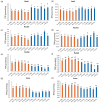Morphological and Photosynthetic Pigment Screening of Four Microgreens Species Exposed to Heavy Ions
- PMID: 39771239
- PMCID: PMC11678762
- DOI: 10.3390/plants13243541
Morphological and Photosynthetic Pigment Screening of Four Microgreens Species Exposed to Heavy Ions
Abstract
Numerous challenges are posed by the extra-terrestrial environment for space farming and various technological growth systems are being developed to allow for microgreens' cultivation in space. Microgreens, with their unique nutrient profiles, may well integrate the diet of crew members, being a natural substitute for chemical food supplements. However, the space radiation environment may alter plant properties, and there is still a knowledge gap concerning the effects of various types of radiation on plants and specifically on the application of efficient and rapid methods for selecting new species for space farming, based on their radio-resistance. Thus, the hypotheses behind this study were to explore the following: (i) the pattern (if any) of radio-sensitivity/resistance; and (ii) if the morphological parameters in relation with pigment content may be a feasible way to perform a screening of radiation responses among species. To perform this, we irradiated dry seeds of basil, rocket, radish, and cress with iron (56Fe; 1550 MeV/(g/cm²)) and carbon (12C; 290 MeV/u, 13 keV/µm) heavy ions at the doses of 0.3, 1, 10, 20, and 25 Gy to investigate the growth responses of microgreens to acute radiation exposure in terms of morphological traits and photosynthetic pigment content. Results indicate that the microgreens' reaction to ionizing radiation is highly species-specific and that radiation is often sensed by microgreens as a mild stress, stimulating the same morphological and biochemical acclimation pathways usually activated by other mild environmental stresses, alongside the occurrence of eustress phenomena. Over extended periods, this stimulus could foster adaptive changes, enabling plants to thrive in space.
Keywords: carbon ion; ionizing radiation; iron ion; microgreens; photosynthetic pigment content; space biology.
Conflict of interest statement
The authors declare no conflicts of interest.
Figures











References
-
- Xu T., Ma C., Aytac Z., Hu X., Ng K.W., White J.C., Demokritou P. Enhancing agrichemical delivery and seedling development with biodegradable, tunable, biopolymer-based nanofiber seed coatings. ACS Sustain. Chem. Eng. 2020;8:9537–9548. doi: 10.1021/acssuschemeng.0c02696. - DOI
-
- Gupta A., Sharma T., Singh S.P., Bhardwaj A., Srivastava D., Kumar R. Prospects of microgreens as budding living functional food: Breeding and biofortification through OMICS and other approaches for nutritional security. Front. Genet. 2023;14:1053810. doi: 10.3389/fgene.2023.1053810. - DOI - PMC - PubMed
-
- Taylor A.J., Beauchamp J.D., Briand L., Heer M., Hummel T., Margot C., McGrane S., Pieters S., Pittia P., Spence C. Factors affecting flavor perception in space: Does the spacecraft environment influence food intake by astronauts? Compr. Rev. Food Sci. Food Saf. 2020;19:3439–3475. doi: 10.1111/1541-4337.12633. - DOI - PubMed
-
- Rizvi A., Sharma M., Saxena S. Microgreens: A Next Generation Nutraceutical for Multiple Disease Management and Health Promotion. Genet. Resour. Crop Evol. 2023;70:311–332. doi: 10.1007/s10722-022-01506-3. - DOI
LinkOut - more resources
Full Text Sources
Miscellaneous

